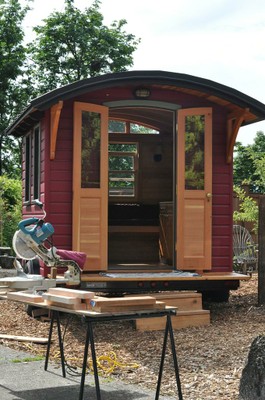 There are many ways to compare Portland and Seattle, some of which we covered in our blog post comparing the cities last year. But one way that Portland outdoes Seattle is in small houses. Portland not only has an active love affair with small houses, but it actually encourages their development and construction by reducing permitting costs.
There are many ways to compare Portland and Seattle, some of which we covered in our blog post comparing the cities last year. But one way that Portland outdoes Seattle is in small houses. Portland not only has an active love affair with small houses, but it actually encourages their development and construction by reducing permitting costs.
Nationally, American’s houses are getting smaller and so are lots. That’s a positive indicator since bigger houses have bigger carbon foot prints, use more energy, and create more impacts to surface water run off. Portland’s embrace of small houses has been enthusiastic while the Seattle City Council spent many months wringing its hands before deciding to allow cottages citywide. The next step is to encourage them to be built. Portland sets a great example.
In Portland, houses are not bumping up against the maximum size but are actually getting smaller than the prescribed limit of 800 square feet. Typically, the small-house debate in the region has been about how big “detached accessory dwelling units” should be, and how that size should be determined. Here’s a video of a recent bike tour of micro houses that was part of Pedalpalooza.
The houses featured in the Pedalpalooza tour were all less than 800 square feet with some as small as a few hundred square feet. Schuyler’s House featured in the video is closer to 300 square feet. And as I pointed out in a previous post, many tiny houses in Portland are taking advantage of a co-housing model which allows shared use of common space for cooking.
Besides being a great idea—putting bikes and small houses together—the Pedalpalooza tour is building on an enthusiasm for small houses that is being picked up by City Hall. In fact, Portland policymakers are lowering barriers to small house construction by reducing what are known as “System Development Charges” (SDCs) that are applied to new structures on single family lots. All told, the SDCs for a typical small detached dwelling unit could be as high as $7500, almost 10 percent of the cost of a low-end cottage, which the City of Seattle estimates running about $80,000. That’s enough to be discouraging. So Portland has suspended SDCs on accessory dwelling units until the summer of 2014. That is a significant cost savings that might make the difference. Building or remodeling a new living space is complicated enough without additional expenses. Cutting red tape and fees takes away a significant barrier for homeowners considering adding a small house.
Seattle, however, will still charge a property owner in the neighborhood of $2,000 just for plan-review and permitting. Those costs might not seem prohibitive for a larger project, but it says a lot about the attitude of Seattle leaders toward small houses. At a time when home ownership is being transformed from an investment opportunity for families to a burdensome and potentially untenable depreciating asset, micro houses provide the potential for additional rental income for existing property owners and low cost housing for renters, often in desirable neighborhoods. In some cases, for example, constructing an accessory dwelling unit can provide an affordable option for an aging family member instead of assisted living. Micro houses also support more density within single family neighborhoods, providing a sustainable alternative to apartment or condo living. Hopefully, Seattle will take a page from Portland’s playbook, not just tolerating micro houses but encouraging them to proliferate.
Portland Alternative Dwellings Little house workshop 2010 from Flickr user Rowdykittens under the Creative Commons license.








John Newcomb
Overlooked in this micro-housing article is the role that travel trailers (TTs) could play in providing good, long-term housing for low-income and marginalized people. The obvious problem of TTs is their long-standing reputation as housing only for trailer trash, whereas the “micro houses” reek of architectural design for the wealthy. Not that the wealthy would even want to live in micro-housing, but its the wealthy who are the political gate-keepers who control the urban permitting process – and they know full well that expensive micro-housing will never catch on. However, quality TTs are much cheaper to build, and with their mobility, they could actually be taken to sewage dumpout stations and water supply points, thus reducing the SDC’s associated with them. Just for example, here is link to plan of $15,000 new Jayco TT that makes incredibly good use of its 160 sq ft: http://www.jayco.com/php/products/build.price.php?step=3=245More expensive are housing modules that can be readily moved onto sites at a fraction of site-built housing. Example is in my city of Saanich, BC: “Building modules from 2010 Olympics to house homeless in Saanich”: http://www.timescolonist.com/news/Building+modules+from+2010+Olympics+house+homeless+Saanich/3377993/story.html